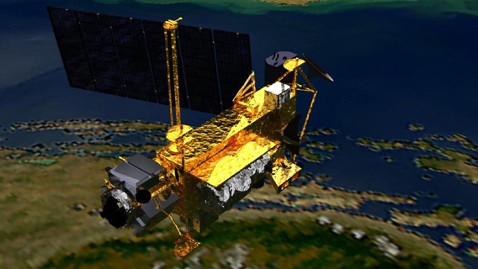NASA Satellite Falling to Earth: Will You Be Hit?

UARS Satellite. NASA artist's conception.
What are your chances of getting hit by a piece of space junk? Yes, yours personally?
In a teleconference today, Nicholas Johnson, NASA’s chief scientist for orbital debris in Houston, said your odds of getting bonked by something from orbit are about 1 in 21 trillion, so rest easy. But he said the chances of someone, somewhere on this planet, getting hit by a piece of NASA’s UARS satellite are 1 in 3,200.
Which is why NASA’s a bit worried, and why today’s teleconference will be followed by weekly and then daily updates until UARS’ remains crash to Earth, probably in late September or early October.
UARS — short for Upper Atmosphere Research Satellite — has been in orbit since the space shuttle Discovery launched it in 1991, but it’s gradually coming closer and closer to the ground as it encounters friction from the upper reaches of the atmosphere. As of Thursday, it was in an orbit 152 miles high at minimum. It ran out of fuel, which it could have used to ditch itself in the Pacific, back in 2005.
Dead satellites fall from orbit all the time, but most of them burn up as they descend into thicker layers of air. UARS, though, weighed six tons at launch, and engineers say 1,200 lbs. of metal chunks could well make it down to the surface.
Where might it come down? That’s the problem. The satellite is in an orbit that takes it 57 degrees north or south of the equator. If you live south of, say, Juneau, Alaska or Inverness, Scotland — or anywhere north of Punta Arenas, Chile or the southern tip of New Zealand — UARS has been occasionally passing over you for 20 years.
Still — a 1-in-3,200 chance that someone could get hit?
“Things have been re-entering ever since the dawn of the Space Age; to date nobody has been injured by anything that’s re-entered,” said Gene Stansbery, Johnson’s colleague in the NASA orbital debris office. “That doesn’t mean we’re not concerned.”
Engineers have quietly said in the past that this is more of a public relations problem than an actual threat. Even though the planet’s population is passing 7 billion, it’s surprising how much elbow room we have. Seventy percent of the surface is water; most of the rest is mountain, desert, tundra or open farmland. By some estimates, we humans really use only about five percent of the land on this planet. Robert Kunzig of National Geographic pointed out this year that if you took all 7 billion of us and had us stand shoulder-to shoulder, we would all fit in an area the size of the city of Los Angeles.
Places like Los Angeles — to say nothing of Chicago, New Delhi, Shanghai, Lagos and countless other cities — are indeed crowded; hence the worry. But there’s no saying it will come at all close to one of them, or end up leaving pieces in eastern Siberia or the southern Pacific.
“We simply will not know where it’s going to come down until it comes down,” said Air Force Maj. Michael Duncan of the U.S. Strategic Command.